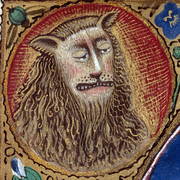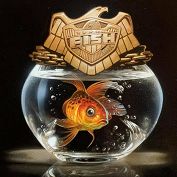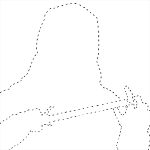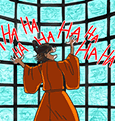|
So did everyone in the Middle Ages have boobs on their shoulders?
|
|
|
|

|
| # ? May 8, 2024 17:25 |
|
One of the common jokes is that most male artists in those days were in fact not interested in women so they drew male bodies and just kinda tossed the female anatomy on top of it.
|
|
|
|
Maybe those aren't boobs, but swollen lymph nodes from bubonic plague.
|
|
|
|
Talk about having wood.
|
|
|
|
He's a monk he ain't ever see titties before.
|
|
|
|
I've seen some illustrations that featured more saggy boobies but I think they liked the look of firm, girlish ones. That said, I've noticed that male anatomy seems to be understood better or is maybe just portrayed more realistically. I have no clue whether that is a choice or down to the fact that female models weren't available, I like medieval art but I'm no historian.  Biblioteca Nacional de Espaņa, Cod. Vitr. 24-3, detail of f. 10v. Libro de horas de Carlos V. Paris (workshop of Jean Poyer?), late 15th/early 16th century. This dude's torso shows that the artist had a good grasp of anatomy but the woman is just a complete mess. The artist clearly knows where navels go but whelp. A pretty good read about sex/women in the Middle Ages: http://www.lib.rochester.edu/camelot/medsex/text.htm Phobophilia posted:He's a monk he ain't ever see titties before. These guys never have, ugh gross titties  This guy was seduced by an evil lady  But this couple is up to no good and liking it  And if a monk gets too bold, just hit him with your slipper!  Clearly reading a good book.   And lastly, what looks like a great party: 
PiratePing fucked around with this message at 11:59 on Apr 21, 2013 |
|
|
Phobophilia posted:He's a monk he ain't ever see titties before. Pretty much:  http://oglaf.com/sexmanual/ http://oglaf.com/sexmanual/
|
|
|
|
|
I'd like to know more about the Free Companies and other mercenary companies. Any suggested reading for them? Assume I know nothing except "Hey, that sounds neat".
|
|
|
|
I've read that during the Mongol invasion of the 'Russian' states, the Mongols made their arrows in such a way that the Russians couldn't use them after they'd been fired, whereas the Mongols could re-use the Russian arrows fired at them. So how's that work? This is from multiple sources, most recently "Genghis Khan and the Making of the Modern World" by Jack Weatherford.
|
|
|
|
For whatever its worth, I've dyed wool using woad, and didn't notice any weird psychological effects, even when I deliberately smeared some of the sludge on me for the sake of SCIENCE!, although it did turn me blue until it wore off. I've spoken to several other people who have a lot of direct skin contact with woad, and all of them had the same experience-woad makes your skin blue, it doesn't give you an overwhelming urge to charge a shield wall. Its entirely possible that berserkers put something into the woad mixture that did mess with them, or that the ritual of painting themselves with woad helped them get into the zone, but the woad itself is unlikely to have done anything, unless they were using some kind of magic Scandanavian woad that is lost to history.
|
|
|
|
Obdicut posted:I've read that during the Mongol invasion of the 'Russian' states, the Mongols made their arrows in such a way that the Russians couldn't use them after they'd been fired, whereas the Mongols could re-use the Russian arrows fired at them. Vikings had a pin in some of their spearheads they could take off before throwing. Then when the spear hits, the head comes off. Maybe the arrows worked likewise? Alhazred posted:Pretty much: Hogge Wild fucked around with this message at 23:44 on Apr 21, 2013 |
|
|
|
Obdicut posted:I've read that during the Mongol invasion of the 'Russian' states, the Mongols made their arrows in such a way that the Russians couldn't use them after they'd been fired, whereas the Mongols could re-use the Russian arrows fired at them. I don't know for sure but here are a few guesses: 1. I vaguely remember reading in some medieval manual about how some archers (Turks I believe?) fit a small blade in the nock of their arrows. The archer would then have a special ring (bone or metal probably) on his bow which would prevent the blade from slicing his bowstring, but if an enemy picked up the arrow and tried to use it, it would ruin his bowstring. It wouldn't slice it in half or anything, but it would make the bow dangerous to use because the string could snap. Of course this isn't lethal, but I don't think anyone wants to get smacked in the face by their bow/bowstring as it snaps. 2. I know the Sioux and other native American tribes attached arrowheads with a sinew wrap that would loosen or break off after the arrow had been fired and penetrates the target. Whatever you hit has the arrowhead in it, but pulling the arrow out would only yield the shaft. Even if you missed and hit the ground, the head still breaks off. Maybe something similar was done by the Mongols. A pin in the shaft like Hogge Wild referred to is basically the same concept. 3. Not sure how big Mongol bows were compared to the bows the Russians were using, but maybe their arrows just weren't long enough to fit over the Russian bows when they were drawn? This probably isn't likely though. I don't know anything about the specifics of archery related stuff.
|
|
|
|
canuckanese posted:I don't know for sure but here are a few guesses: The first sounds like it, because it's usually described as having something to do with the notching of it. And I hate incomplete information like that. If you're going to put in your book that the Mongols could use Russian arrows but not vice versa, explain why, or say it's unknown.
|
|
|
|
Obdicut posted:The first sounds like it, because it's usually described as having something to do with the notching of it. With the notching, it wouldn't even necessarily have to be a blade in it. It could be something as simple as having a notch which only fits the strings of Mongol bows, but is too narrow to be nocked on a Russian bowstring. The incomplete information thing always bothers me too. Just add another sentence or two and tell us WHY it doesn't work.
|
|
|
|
It could also be something like what the Romans did with their pila spears. That is, the head is attached to a heavy shaft with a thin piece of metal (IIRC) that would bend whenever it hit anything so that the pilum would go from a perfectly serviceable throwin' spear to a bent stick that was pretty useless in combat, thus the enemy couldn't just pick up Roman spears and chuck them back. I'm not sure if this question's been asked, but were there any stereotypes on a national (for lack of a better word) basis? Like, did the French have a stereotype for the English, the Italians for the French, etc? I remember looking at a print made during the Thirty Years' War (so outside the scope of this thread, but still) depicting Scottish and Swedish mercenaries as fur-clad barbarians, so there must've been something. Any examples that stand out?
|
|
|
|
Buried alive posted:Related question: What's the low-down on viking berserkers? I've heard that nordic/viking war paint was made out of some sort of plant with hallucinogenic properties, so these guys would get high as balls and then just charge the front lines of whatever it was they were facing off against. Any truth to that? There are various theories about drugs or psychology, but it's worth pointing out that sources don't agree exactly how effective the berserkers were. Some sagas describe them as nearly unkillable monsters dedicated to tearing apart the enemy, other writers described them as frenzied and unreliable fighters. Are there good, modern historical analyses considering how effective real berserkers were in battle?
|
|
|
|
NEED TOILET PAPER posted:It could also be something like what the Romans did with their pila spears. That is, the head is attached to a heavy shaft with a thin piece of metal (IIRC) that would bend whenever it hit anything so that the pilum would go from a perfectly serviceable throwin' spear to a bent stick that was pretty useless in combat, thus the enemy couldn't just pick up Roman spears and chuck them back. Pretty much, the Pilum was around 4-5 feet of wood shaft with an additional 1-2 feet of unhardened iron shaft with a hardened point. When thrown, the hardened point could go through a wooden shield, and the weight of the shaft coming behind it would bend the shaft enough that it would be a lot harder to pull the thing out, especially when dudes with swords are coming right after it. On the arrows thing, could the Mongol arrows simply have been too big for Russian bows to fire easily? The Mongols used a very high poundage bow that would have needed a very thick arrow to handle the stresses. If the arrows were big enough, Russian bows would not be able to give them enough oomph to do much damage at a decent distance.
|
|
|
|
NEED TOILET PAPER posted:It could also be something like what the Romans did with their pila spears. That is, the head is attached to a heavy shaft with a thin piece of metal (IIRC) that would bend whenever it hit anything so that the pilum would go from a perfectly serviceable throwin' spear to a bent stick that was pretty useless in combat, thus the enemy couldn't just pick up Roman spears and chuck them back. I doubt it was that. I think a lot of that was so the pilum would trip them up and drag on their shields and stuff. Arrows you have much less force to work with and I doubt you'd want to sacrifice any by having it bend like that. You'd want the full weight of it driving in the point. I'm betting it was just having a notch that was too narrow, or one that fitted against a special piece on the bowstring (whether with a blade or just a little button or something) given that the limited references I've seen always talk about the notching of it. The bent arrows is easier to explain and would probably be mentioned specifically. It's also not recorded, as far as I know, in any other Mongol battle.
|
|
|
|
By the way arrows are shot not fired. A pet peeve of mine, and one of the few things that Braveheart got right. Someone has asked the same question as you: Straight Dope
|
|
|
|
Hogge Wild posted:By the way arrows are shot not fired. What about fire arrows
|
|
|
|
Obdicut posted:I'm betting it was just having a notch that was too narrow, or one that fitted against a special piece on the bowstring (whether with a blade or just a little button or something) given that the limited references I've seen always talk about the notching of it. The bent arrows is easier to explain and would probably be mentioned specifically. It's also not recorded, as far as I know, in any other Mongol battle. This is most probably correct, but I'd be curious to know what primary source this comes from. It sounds like an oddly specific bit of information to be wholly fanciful, but other battle accounts exist which were written long, long after the fight that have little bearing on reality, but have nevertheless been treated as reliable sources by incautious scholars; the 13th century account of the Saxons fighting on horseback at Stamford Bridge comes to mind.
|
|
|
|
Rodrigo Diaz posted:This is most probably correct, but I'd be curious to know what primary source this comes from. It sounds like an oddly specific bit of information to be wholly fanciful, but other battle accounts exist which were written long, long after the fight that have little bearing on reality, but have nevertheless been treated as reliable sources by incautious scholars; the 13th century account of the Saxons fighting on horseback at Stamford Bridge comes to mind. I 99% know I saw it elsewhere, other than just the cool-but-rather-pop book. I'll try to confirm that and see if there's any reference for it. I haven't seen references for it in other battles that the Mongols engaged in, but most of their archer vs. archer battles were vs. other steppe tribe types who were more likely to have a similar bow. Do bowstrings survive well?
|
|
|
|
Obdicut posted:I 99% know I saw it elsewhere, other than just the cool-but-rather-pop book. I'll try to confirm that and see if there's any reference for it. I haven't seen references for it in other battles that the Mongols engaged in, but most of their archer vs. archer battles were vs. other steppe tribe types who were more likely to have a similar bow. The thing is the same thing could be said about Rus' much of the time. Especially in the South (where Kiev, Chernigov, and Pereyaslavl are) exposure to the steppe nomads would have been fairly substantial. Defence against steppe raids or expeditions against them were quite normal, and one of the most famous was Igor of Novgorod Seversky's campaign, which is preserved as an epic. Bowstrings survive horribly. We have a complete one from Mary Rose but I don't think anywhere else. Someone please correct me if I'm wrong. Edit: I'd also point out that they don't have to be pop-historians to be incautious. R. Glover was one of the chief users of the above source and I would not call him a pop-historian. Rodrigo Diaz fucked around with this message at 19:57 on Apr 22, 2013 |
|
|
|
Rodrigo Diaz posted:The thing is the same thing could be said about Rus' much of the time. Especially in the South (where Kiev, Chernigov, and Pereyaslavl are) exposure to the steppe nomads would have been fairly substantial. Defence against steppe raids or expeditions against them were quite normal, and one of the most famous was Igor of Novgorod Seversky's campaign, which is preserved as an epic. I think that the particular Rus force they faced at that point was a "Europeanized" one, but you're right that they faced the Kikchick(sp?) and a bunch of other steppe tribes using very similar weapons. It's going to remain a puzzler; as you say, it's a weird detail to just suddenly make up, but it's also hard to figure out why it would happen, why it's not mentioned in another story of Mongol warfare, and why it would surprise the Rus in particular since they were used to fighting steppe nomads. In a semi-related question, what did the European armies use for communication on the battlefield? I assume that there were various technologies employed at various times, but I'm thinking here of the Mongol verse-order thingy, where they had a preset verbal format for orders that made them harder to confuse, and also a strong flag-signal structure to use when vision was good, and also a system of verbal calls. What I'm mostly interested in, I guess, is if any armies had significant advantages, as the Mongols did, due to the utility or redundancy of their signal corps.
|
|
|
|
Iseeyouseemeseeyou posted:What about fire arrows Fired, then shot?
|
|
|
|
As far as I'm aware, the mongols used braided horse hide as string. This would probably have made them pretty thick, so that mongol arrows would have had special nocking. But then again, that makes sense, because with a bow that had the kind of poundage that the mongol bows had, splitting the nock is common problem. If your bow is strong enough, a traditional nock may split the arrow rendering it unusable and possibly unstable in flight. This is a problem shared by crossbow bolts, and the reason why they aren't nocked like arrows. So it's conceivable that the mongol arrows weren't nocked in the traditional sense, and that the mongols used a special string with some way of holding the arrow like a pocket or a loop, or a gap between braids to "nock" the arrow to the string. That would allow them to use any old arrow, but if you have a regular bow string you wouldn't be able to use a mongol arrow on your bow, because it doesn't have a nock. Pulled completely out of my rear end, but it's a theory I guess.
|
|
|
|
Nice piece of fish has seen fit to criticize the swordsmanship on display in the Game of Thrones TV show. And so, Medieval History & Combat thread, what do you have to say about the fearsomely beweaponed combat therein? And most importantly -- should it be more like Ong Bak?
|
|
|
|
That fight on the bridge between Jaime and Brienne was one of the worst things I've seen in ages
|
|
|
|
Rabhadh posted:That fight on the bridge between Jaime and Brienne was one of the worst things I've seen in ages I just look at the video; I don't watch the show. Clearly they're in love and know they're being watched so they're pretending to fight while trying not to hurt each other, right?
|
|
|
|
Chamale posted:I just look at the video; I don't watch the show. Clearly they're in love and know they're being watched so they're pretending to fight while trying not to hurt each other, right? I was grumbling that she should just take his attacks on her armor throughout the entire scene. What's Jaime going to do? Cleave through steel plate?
|
|
|
|
Obdicut posted:I think that the particular Rus force they faced at that point was a "Europeanized" one, but you're right that they faced the Kikchick(sp?) and a bunch of other steppe tribes using very similar weapons. It's going to remain a puzzler; as you say, it's a weird detail to just suddenly make up, but it's also hard to figure out why it would happen, why it's not mentioned in another story of Mongol warfare, and why it would surprise the Rus in particular since they were used to fighting steppe nomads. Kipchak is the word you're looking for. Igor's campaign was against the Cumans. There were also the Pechenegs and the Volga Bulgars. The latter were less nomadic but came from a similar military tradition. I have seen mention of trumpets and banners as signalling devices, as well as carrier pigeons for communication during siege. While I haven't looked very carefully at the use of trumpets, banners seem to only deliver very simple commands, typically 'advance', 'withdraw', or 'gather here', depending on the context, with more complicated manoeuvres delivered verbally. In the Templar Rule, for example, the standard of one's squadron was the place where knights would regroup after delivering a charge, and throughout medieval warfare the standard bearer was an important role. Arglebargle III posted:Nice piece of fish has seen fit to criticize the swordsmanship on display in the Game of Thrones TV show. And so, Medieval History & Combat thread, what do you have to say about the fearsomely beweaponed combat therein? And most importantly -- should it be more like Ong Bak? The swordsmanship has been lovely, even for mass media type stuff. So have the swords, to be honest. I mean, look at this piece of crap:  Looks like it was injection molded in china and sold exclusively at your local pharmacy. Also there are like 0 arming swords in the entire world.
|
|
|
|
The GoT choreography is pretty standard fare for a fantasy show or movie: they don't swing at each other, they block with the edge and just pull their swords back to bash them together again, and so on. And they seem to have this idea that knights were slow lumbering monsters swinging heavy bars of steel so they're also really slow and clumsy. It really does take away from the sense that these people are trained knights and poo poo, but of course the vast majority of watchers are not going to notice or care. Still, I can't help but feel that getting even some of the basics (like "aim at your opponent, dude" and "parry properly, goddamn it" and "you aren't going to do poo poo cutting at plate") down would improve the fight scenes considerably.
|
|
|
|
Rodrigo Diaz posted:Also there are like 0 arming swords in the entire world. Dumb question, but the problem is that they're all huge, right? (Somewhat) Related question: was the cruciform hand-guard a Christian thing or is it just an easy way to make a sword? I've heard both, but it seems like non-Christian swords frequently had a blade stop that covered more than two angles.
|
|
|
|
Arnold of Soissons posted:Dumb question, but the problem is that they're all huge, right? Everyones rolling with bastard swords and greatswords even though they're mostly mounted. Come to think of it you don't see many lance armed cavalry either though.
|
|
|
|
Rodrigo Diaz posted:standards etc. I should have said, Gutierre Diaz de Gamez, the author of the biography of Don Pero Niņo, was himself a man-at-arms, and frequently served as Don Pero's standard bearer. He actually includes a mini-treatise on the standard and its role in combat. Gutierre Diaz de Gamez posted:Well do soldiers know that all have their eyes on the banner, enemies as well as friends; and if its men see it retreat in the battle, they lose heart, while the enemies courage waxes; and if they see it stand firm or go forward, they do the same. But neither because the standard-bearer is granted such and honour, and has been chosen out of the whole army to fill this office, nor because all look to him and have their eyes upon him, must it happen that pride and vanity wax within him, and that he ascribes to himself a greater part than has been assigned to him, that he march more in the van than has been ordered, or that he think that his charge has been given to him as being the most valiant man in the army. He must tell himself that many other and better men are round him and that it is they that do the work. Let him not wish to distinguish himself and excel another in honour, so that in the end he endangers the honour of his master and those who follow him; neither let him keep himself so far behind that the rest advance and he remains in the rear; for a candle gives more light when it is borne before than behind, and the standard is like a torch set in a room to give light to all men; if by some accident it is put out, all remain in darkness and unseeing and are beaten. And so for such an office should there be chosen a man of great sense, who has already been seen in great affairs, who has good renown and who on other occasions has given a good account of himself. Such a work should be given neither to a presumptuous man, nor to a hasty man, for he who is not master of himself cannot lead others. And some to whom this office has been entrusted have brought their masters and those who follow them into evil straits, since the lord has bidden his men follow the banner. Great reason is there to reproach that lord who sets his men under such a standard-bearer, for honour so works upon gentlefolk that it drives them into certain danger. So it is fitting that the standard-bearer should conform to the will of his lord and should not do more than he is ordered. Diaz then relates Don Pero's command to him to advance. Gutierre Diaz de Gamez posted:"Friend, take heed when you hear the trumpets sound; then march forward with the standard and go forward up to the English. There make your stand and leave it not." So, ultimately, a fairly simple tool, but very good at its job. Arnold of Soissons posted:Dumb question, but the problem is that they're all huge, right? Yes. Do you explicitly mean the guard or the overall shape of the sword? Because not all European swords were cruciform, nor indeed were all swords with straight guards. It's not just an easy way to make a sword, and is actually more intensive than the Roman method Abbasid and Mamluk swords were also frequently cruciform, so it's not a Christian Thing. The shape of the sword was incorporated as part of Christian imagery, but that is not why it came to be. The xiphos was also cruciform. It's not really 'easier' to make. Easier would be hilt-less swords, or swords that were much shorter, like the scramasax. Additionally, I'd argue single-edged weapons are easier to make than two-edged, having made knives of both forms, but that's just my experience.
|
|
|
|
Rodrigo Diaz posted:Do you explicitly mean the guard or the overall shape of the sword? Because not all European swords were cruciform, nor indeed were all swords with straight guards. It's not just an easy way to make a sword, and is actually more intensive than the Roman method Abbasid and Mamluk swords were also frequently cruciform, so it's not a Christian Thing. The shape of the sword was incorporated as part of Christian imagery, but that is not why it came to be. The xiphos was also cruciform. I see what you mean about it not being the simplest thing possible, but it seems a flat cross guard must be easier to fabricate than a basket hilt or something. Honestly, the question comes to mind because I remember some people nerding that the swords in GoT shouldn't have such a universal cruciform silhouette, since they aren't swords from medieval Christendom but from the land of the Seven Gods and so on and so forth.
|
|
|
|
I have read that cruciform is so prevalent because it allows the user to hook one finger over the cross, giving you more control over the blade. Particularly because the sword was mainly drawn after the charge, when a knights hand could be slippery from either sweat or blood.
|
|
|
|
Arglebargle III posted:Nice piece of fish has seen fit to criticize the swordsmanship on display in the Game of Thrones TV show. And so, Medieval History & Combat thread, what do you have to say about the fearsomely beweaponed combat therein? And most importantly -- should it be more like Ong Bak? Yes, I did see fit to do that. Well, I guess that wasn't very clever of me, but it annoys me that a series that ostensibly derives its popularity (books and tv series) from being different than standard fantasy trope, isn't seen as a great loving opportunity to do something different with knightly combat. Just for once, show the knights for the top-athlete murdermachines they were instead of actresses smacking eachother with pointy metal clubs. Also, Ong Bak (well the first one and the first of the new ones) is a cool movie, but has nothing to do with realistic combat. But if you gave me the choice of that kind of combat and the loving olympic fencing "emotional and character developing" fight scenes, I'd take the one with actually entertaining fights. So, there's stuff like this, this and this which are apparently regarded as good fight scenes. Well, I kind of like the Troy scene because it kind of looks like they know what they are doing, and swords appear to have weight and force behind them, but still. And then there's this, and it would apparently be terrible if knights moved more like that. Or maybe they'd do a murder-stroke now and then. It doesn't mean that fights need to be over in 3 seconds flat, but I just couldn't see the harm in having wannabe knights actually looking like they've ever trained at swordsmanship. I mean, we've lost most of what medieval/renaissance martial art there was, but we do know some stuff, and I think it's a shame it's not more prevalent in mainstream media. Knights were a lot more badass than they are presented, and I don't see the harm in showing that. But apparently this is criticism of the show and you're not allowed to do that, so... Nice piece of fish fucked around with this message at 23:25 on Apr 23, 2013 |
|
|
|
Arglebargle III posted:Nice piece of fish has seen fit to criticize the swordsmanship on display in the Game of Thrones TV show. And so, Medieval History & Combat thread, what do you have to say about the fearsomely beweaponed combat therein? And most importantly -- should it be more like Ong Bak? My biggest complaint from the bits I've seen is that they made a big fuss about how they'd brought in William Hobbs and were going to be using realistic techniques and blah blah blah. The problem is the choreography they've settled on isn't anywhere near realistic enough to be interesting to anyone who's watched SCA heavy combat, let alone full-speed reconstructed techniques, and it's not well-choreographed enough to be fun to watch on its own merits. Somehow in trying to make the combat more realistic, they managed to make it the most boring and awful thing. It's also worth noting that William Hobbs was the choreographer for The Three Musketeers in 1973, which has some of the best fight choreography I've ever seen, even if it's not the most realistic. It's not like the guy doesn't know how to make a fight scene look good, but I guess he's either gotten a lot worse or doesn't get to have fun with things.
|
|
|
|

|
| # ? May 8, 2024 17:25 |
|
Makrond posted:My biggest complaint from the bits I've seen is that they made a big fuss about how they'd brought in William Hobbs and were going to be using realistic techniques and blah blah blah. The problem is the choreography they've settled on isn't anywhere near realistic enough to be interesting to anyone who's watched SCA heavy combat, let alone full-speed reconstructed techniques, and it's not well-choreographed enough to be fun to watch on its own merits. Somehow in trying to make the combat more realistic, they managed to make it the most boring and awful thing. I love the show, but I have to agree here. The fights so far have been rather uninspiring.
|
|
|



































